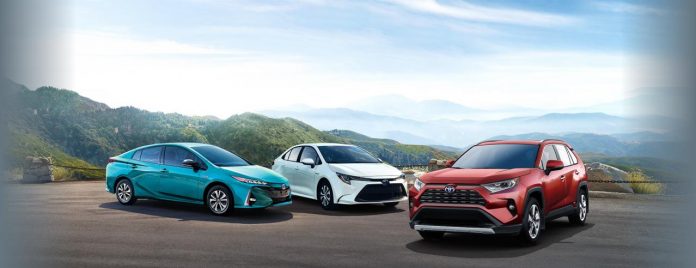Car manufacturers in Indonesia are showing a shift in trend, moving increasingly toward producing more environmentally friendly vehicles, following the issuance of Presidential Regulation No. 55/2019 on accelerating the electric motor vehicle program.
One carmaker ready to comply with the regulation is Toyota, which is offering two types of electric cars in the country: the Hybrid Electric Vehicle (HEV) and the Plug-In Hybrid Electric Vehicle (PHEV).
The HEV has two engines: one that uses gasoline and an electric motor that is powered by a battery. The two engines combine to achieve optimum fuel efficiency, and the vehicle can rely solely on the battery-powered engine if the gasoline engine stalls. This battery stores the kinetic energy it captures from braking and is also powered by the gasoline engine.
Toyota’s HEV models already in distribution in Indonesia include the Camry Hybrid, the Alphard Hybrid, the Altis Hybrid, the CHR Hybrid and the Prius Hybrid.
The PHEV is also a hybrid vehicle that contains both a gasoline and an electric engine, but the difference is that it has a battery that can be recharged by external power sources like charging stations as well as home and office electrical outlets. The PHEV operates primarily on the electrical engine, with the gasoline engine taking over when the battery is depleted.
While luxury carmakers BMW and Mercedes-Benz are already selling their PHEV cars in Indonesia, Toyota has started manufacturing its PHEV cars, like the Prius PHEV, but is still studying the Indonesian market before selling them.
HEV cars are currently the best choice for environmentally conscious customers interested in heading down the road to the electric car era, because they combine an electric motor with a conventional fuel-powered engine.
This hybrid system has the zero-emission advantage of the electric engine that is supported by a fuel-saving conventional engine and does not depend on the battery capacity, because the HEV battery is charged by the conventional engine. Their cruising range is also the same as that of conventional cars, because the battery is internally charged.
In addition, these hybrid cars are practical, as they still rely on gas stations the way conventional cars do. As a bonus, they are more soundproof.
With their practicality and ease of use, HEV cars are expected to enjoy smooth entry to the Indonesian market.
The Jakarta Post was recently invited by distributor Toyota-Astra Motors to test drive four of its HEV cars (Alphard Hybrid e-Four, Camry Hybrid, CHR Hybrid, Corolla Altis Hybrid) and one PHEV, the Prius Plug-in Hybrid, on Oct. 9 to 11 from Banyuwangi, East Java, to Denpasar, Bali. The route passed through Baluran National Park before taking a one-hour ferry crossing from Ketapang Port in Banyuwangi to Gilimanuk Port on Bali.
The test drive offered two distinct points, with the first being fuel consumption.
Fuel consumption data from Toyota-Astra Motor are as follows; Toyota C-HR can run up to 28 kilometers per liter of fuel, Toyota Corolla Altis 26 kilometers, Toyota Camry Hybrid 18.4 kilometers, Toyota Alphard Hybrid e-Four 15 kilometers, and Toyota Prius Plug-In Hybrid Electric Vehicle 55 kilometers.
Interestingly, none of the cars were refueled to full along the 380 km journey, meaning that they saved a lot more fuel and were more environmentally friendly than conventional cars.
The second noticeable point was that all of Toyota’s HEV models come with four driving modes, so drivers can choose the mode that best matches their character: Normal, ECO, Sport and EV.
Normal mode is certainly as named and nothing special, but in ECO mode, the vehicle’s computer – or electronic control unit (ECU) – operates gentler acceleration.
Sport mode displays the engine’s power and accommodates more aggressive maneuvers, while EV mode is relatively silent, since the vehicle switches to the electric motor.
The Gilimanuk-Singaraja-Tabanan highway offered a smooth asphalt road that climbed through mountainous areas and descended in sharp bends as far as Jimbaran, and the test drive ended successfully in Denpasar.
The journey proved the reliability of Toyota’s HEV and PHEV cars and their undoubted performance, handling and power, but the Prius PHEV definitely trumped the others.
The Prius has the advantage of its greater battery capacity of 8.8 kWh, and the battery can be fully charged in about two hours using common household electrical outlets. This means the Prius can travel farther in EV mode at the fairly high torque typical of electric engines, so it was the most comfortable to drive.
In EV mode, the Prius can travel as far as 60 km starting with a full battery, depending on driving technique and road conditions. The range can diminish the more aggressive one drives and the more congested, damaged or winding the road is.
The switch to electric vehicles is just around the corner, but patience is still needed until all necessary supporting infrastructure are ready, like charging stations, to transition through hybrid vehicles to arrive at fully electric vehicles.
Courtesy: The Jakarta Post
